

[Title]
[text TOC]
[image TOC]
[Site Search]
 [Donation]
[Donation]


| Materials |
Tools |
Circuit board
9-volt battery snap
6 white LEDs
LM317 voltage regulator
10-ohm resistor
270-ohm resistor
5 posts
Single throw, double pole switch
9-volt battery
Film canister
Triglide
24"x1" elastic band
3" x 1 1/2" leather
8" wire
2" of 3/16" Heat shrink
1" x 1/4" diameter plastic tubing
3/16" x 1" bolt
3/16" wing nut
3/16" x 2 1/2" screw eye bolt, two nuts
|
Wire wrap tool and wire
Needle and thread
Leather hole punch
Knife
E-6000™ glue
Soldering iron
Blow dryer
Small saw
Wire cutters/strippers
Needle nose pliers
Sandpaper
|
I like this headlamp better than the one or four version for several reasons:
- The LEDs are recessed and protected by the film canister
- The battery can be easily disconnected to make sure it doesn't accidentally turn on in your pack
- The light adjusts up and down more easily
- The LEDs don't produce a glare on my glasses
- It feels much lighter because the battery is next to your head not perched in a container a couple inches from your forehead.
It is also more efficient (lasts longer on a battery). I did a test of a resistor circuit and a voltage regulator and the voltage regulator was brighter and lasted longer than the circuit with only a resistor.
This headlamp weighs 3.25 ounces including the battery. You could probably save some weight by using shorter bolts. The LED flashlight weighs 2.2 ounces itself, so the whole headband and bracket only weigh one ounce. This weight is worth the convenience to me.
I used a single throw, double pole switch. This gives me the option of either using a single LED or all 6. At night inside your tent, you can get by using a single LED. I save the 6 for when I really need it. The single LED will outshine the 6 LEDs when the battery starts going dead (that should be a big hint for you to change the battery) but will last for a LONG time (10 or more hours).

Schematic
These instructions assume that you are familiar with electronics or have already made an LED flashlight. If you haven't, then see the following page for general information on constructing an LED flashlight.

- Make the circuit board
The circuit board (sometimes called proto board) can be cut with wire cutters or a small saw. Cut out a piece to fit inside the film canister. Use sandpaper to smooth the edges and to get the proper fit. Drill a hole for the screw eye in the center of the board. Glue the nut on using E-6000™. Make sure you don't get any glue inside the nut. Place the parts on the board as shown below.
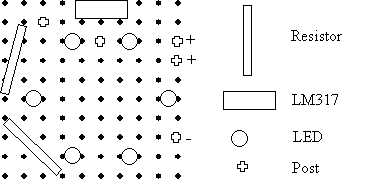
Parts Placement on Circuit Board

Circuit Board
- Wire the board
On the circuit board shown below, the pins are labeled looking at the back of the board (with all the leads sticking through). Starting in the upper left hand corner with 0. There are ten columns and ten rows. The first row is numbered 0-9, the second row 10-19, .. The lower right hand pin is 99. The parts are shown grayed out since they are on the opposite (back) side of the board. The wires for the 6-LED circuit are shown in red, the wires for the single LED are shown in blue. Note that the corners will have to be rounded to fit inside the film canister.
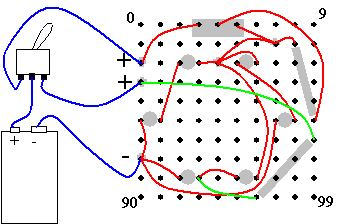
Wiring Diagram
Use wire wrap to make the following connections:
| From |
To |
| For 6 LED circuit |
| 3 |
20 |
| 4 |
59 |
| 5 |
17 |
| 18 |
17 |
| 22 |
51 |
| 23 |
24 |
| 24 |
17 |
| 24 |
26 |
| 24 |
86 |
| 25 |
58 |
| 50 |
70 |
| 57 |
70 |
| 70 |
82 |
| 83 |
85 |
| For 1 LED circuit |
| 30 |
69 |
| 96 |
83 |
Test to make sure both circuits work. Clip the wire leads to the components shorter so they aren't as likely to short with one another.
- Prepare film canister
Using a leather hole punch, make the hole for the screw eye bolt and the switch.
I put the hole for the screw eye in center of bottom. It interfered with the switch, but I got it working. A better way of doing it would be to offset the bolt to one side and place the switch 90 degrees from it. That means that the screw eye bolt will be at a slight angle, but I doubt that it will make much of a difference. Use a small nail to make a hole close to the switch for the 9-volt battery snap wires.
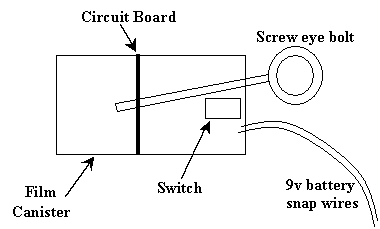
Cutaway view of film canister
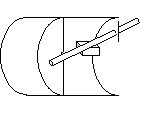
3-D (attempt) of inside film canister
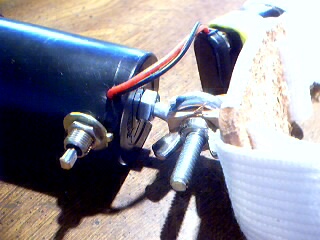
Film Canister
- Assemble light
Push the battery snap wires through the hole. Put heat shrink over the red ("+") battery wire and solder it to the middle terminal of the switch. Solder a 4" piece of wire to the other two terminals of the switch and put heat shrink on them. Solder these two wires to the posts marked "+" in the drawing. Solder the black "-" terminal of the battery to the "-" post. Test the light to make sure the switch works. Use a blow dryer on the heat shrink.
- Put circuit board in Film Canister
Put one nut on the screw eye bolt all the way down to its base. Push the screw eye bolt into the hole in the bottom of the film canister. Push the tubing onto the screw eye bolt. Push the switch through the hole in the film canister and screw it into place. Screw the circuit board into place by holding the nut that is glued to the circuit board with a pair of needle nose pliers and turning the eye part of the bolt. You don't want the circuit board turning and twisting around because it could mess up the wiring. Make sure the circuit board is seated against the plastic tubing. Test to make sure it still works.
- Make the base for the headband
Cut out the leather base, it should be about 1 1/2" square. Use a hole punch to put two small holes 1" apart on two opposite sides of the base. Use a sharp knife to cut slits between the two holes on each side. Cut out two pieces of leather about 3/8" x 1 1/2" for the bracket. Glue them to the base using E-6000™ making an "L" shape with each. Do NOT glue the ends of the bracket together as the screw eye bolt must slide between them. Use clamps (spring clothes pins work) to hold the brackets in place on the base until the glue dries (at least an hour). When the glue has dried, remove the clamps and trim the brackets so the ends are even and do not block the two slits. Punch a hole in the two brackets for the bolt. Push the screw eye between the two brackets, push the bolt through the bracket and screw eye and hold it in place with the wing nut.
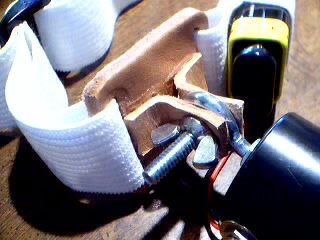
Base
- Make the headband
The 1" triglide is used to adjust the fit of the headband. It can be found in good camping stores and some hardware stores. You may also have a supply close at hand. My boys go through book bags about once a year. You can save the plastic clips from these for use on many projects. You can also make one easily from a scrap piece of plastic or leather.
Put one end of the elastic band through one of the slots on the side and sew it to itself. Put the triglide on the elastic band. Now put the other end of the elastic band through the other side slot and then feed it back through the triglide. Adjust the elastic band so that it fits your head comfortably. Leave some extra elastic band in case you want to put your headband on over a hat. Cut off the excess elastic band. Put a little bit of white glue on the ends of the elastic band to keep it from unraveling.
If you want to put an elastic band on the top, cut a slit in the leather base. Then wrap a piece of elastic around the headband and sew it to itself. This will form a loop around the back of the headband that will allow the top band to slide on the headband. You will want the loop to fit tightly so the top band doesn't slide too much.
Now slide the top band through a triglide. Put the elastic band through the top slot in the leather base and then back through the triglide. Put a little bit of white glue on the ends of the elastic band to keep it from unraveling.
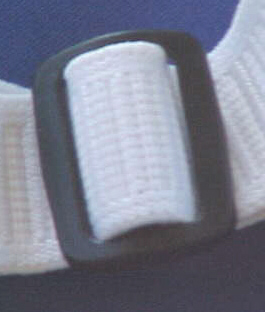
Triglide
- Make the battery holder
The battery is attached to the same side as the switch, which should be on the opposite side from the triglide.
Take a piece of elastic band about 3 1/2" long. Wrap it around the headband as shown in the photos. It needs to be close to the switch because the wires aren't that long. Sew it into place. Make sure it holds the battery tightly. If it is too loose, you could add some sponge or Styrofoam to take up the extra space.

You may want to cut the switch paddle shorter. This will keep it from turning on as often in your pack. Don't cut it too short; there is a small piece inside the paddle. If you cut the paddle too short, this piece will fall out and the switch won't work anymore.
Remove the battery clip from the battery when not in use to make sure it doesn't accidentally get turned on in your pack.
You could make this fairly water resistant by using E-6000™ glue around the screw, switch, and wires (where they come out of the film canister), putting a balloon around the battery and snap, and gluing a piece of clear plastic over the end of the film canister.
The LEDs are by far the most expensive part of the headlamp. You can purchase them for between $2 and $3 USD each depending on the brightness (and where you get them). The materials for the headband, electronics, and hardware will cost about $4 USD. So for $16 and a little time, you can make a GREAT headlamp.
Just a word about brightness. The human eye can discern a difference in two lights if one is twice as bright as the other. That is if one LED is 5,000 mcd and another is 2,000 mcd, you could tell the difference. You probably couldn't tell the difference between 4,000 mcd and 5,000 mcd.
This headlamp was made using 6 LEDs of 9,300 mcd each for a total of 55,800 mcd at a cost of $15 USD. I could also have used 6 LEDs of 6,400 mcd each for a total of 38,400 mcd for $9.60 USD. It's a tradeoff - you'll have to decide what is best for your situation. In the three years that I have been experimenting with white LEDs the brightness has gone from about 3,000 mcd to 9,300 mcd and the price for the brightest LEDs has remained about the same ($2.50). The older, dimmer LEDs go for about half that cost.
Ready for more fun with LEDs? Try these out:

Copyright © 2003 Vincent Hale

 [Donation]
[Donation]

 [Donation]
[Donation]









